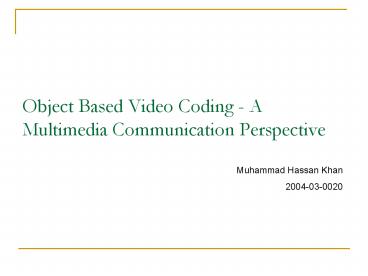Object Based Video Coding - A Multimedia Communication Perspective - PowerPoint PPT Presentation
1 / 15
Title:
Object Based Video Coding - A Multimedia Communication Perspective
Description:
Object Based Video Coding - A Multimedia Communication Perspective. Muhammad Hassan Khan ... mechanism to assign motion information to the segmented objects ... – PowerPoint PPT presentation
Number of Views:55
Avg rating:3.0/5.0
Title: Object Based Video Coding - A Multimedia Communication Perspective
1
Object Based Video Coding - A Multimedia
Communication Perspective
Muhammad Hassan Khan 2004-03-0020
2
Overview
- Motivation for Video Coding
- Todays Video Coding
- Problems with todays video coding
- Desirable Features
- Solution to get desirable features
- Object Based Video Coding
- MPEG-4 Support
- Model Based Coding
- Major Problem Segmentation
- Segmentation by Graph Cuts
- Architecture to Incorporate this segmentation
mechanism with MPEG-4 bit stream
3
Why Video Coding?
- Consider a 1 minute video with 60fps
- No of frames 60 x 60 3600
- Given that each color frame in the video was a
640 x 480 pixels - The size of the raw video comes out to be?
- 3600 x 640 x 480 x 3 3,317,760,000 bits
- Of the order of Gbs
- Now a days one might say that memory is no big
deal BUT - What if we want to transfer this file from one
node to the other node over a network! - Things would collapse very soon
- Just imagine if the video was 1 hour duration
rather than 1 minute!!! - I hope the need for video coding is now obvious ?
4
Todays Video Coding
YUV (lossy)
Motion
DCT
Quantize (lossy)
Entropy
Order
- Designed for natural scenes
- Higher frequency DCT coefficients are quantized
- Sharp edges are not well preserved
5
Problems with Todays Video Coding
- Poor performance in case of
- Anything with sharp edges
- Highly textured regions
- Texts (Channel Logos)
- The bit stream produced by todays coders is also
debatable in that weather it is the MOST optimal
bit stream - In fact what is a most optimal bit stream is
still a question
6
Desired Features
- Better compression
- Improved quality
- Interactivity and Manipulation of Content
- Error Resilience
- Processing of content in the compressed domain
- Identification and selective coding/decoding of
the object of interest - Facilitate Search / Indexing (MPEG-7)
7
Solution to Get Desirable Features
- MPEG-4
- Support for Object Based Coding
- Rather than conventional block based coding for
natural images - The scene should be divided hierarchically into
objects - The scene will now be described by the objects
placed in a hierarchical manner - A sample is presented in the next slide
8
The scene divided into objects
Hierarchical Description
9
The decoding process
10
Meshed Video
- 2D mesh tessellates the video into patches
- Motion vector for each vertex
- Motivation
- Modeling (Motion and Shape)
11
Problems with Mesh Based Coding
- Works fine with previously known models and
caters for a small class of objects - The reliable tracking of features or control
points along the video - E.g. FAPs
- A ready-made model is assumed, 2D or 3D model of
the object has to be known - A more general approach was required
- Object Based Video Coding
- Shape, Color, and Motion
12
Requires a Major Step!
- Segmentation
- Dividing the scene into objects
- In simplest form these objects can be foreground
and background - In more complex situations there can be multiple
objects in the scene - Segmentation is required to extract the objects
- Computing Motion
- Object Based Motion
- Parameterized Motion Information
13
Segmentation by Graph Cuts
- Uses Max-Flow Min-Cut Algorithm from Graph Theory
- Divides the data into regions based on an energy
function, usually employed to the intensities of
the image - A smoothness function is also used to make sure
that the segmentation achieved is consistent - Details will be provided in the final presentation
14
Architecture
- We will also propose mechanism to assign motion
information to the segmented objects - Our approach will be as consistent as possible
with the support provided by MPEG
15
References
- Gary J. Sullivan, Pankaj Topiwala, Ajay Luthra
SPIE Conference on Applications of Digital Image
Processing XXVII, Special Session on Advances in
the New Emerging Standard H.264/AVC, August,
2004 - Gabriel Antunes, Abrantes, Fernando Pereira,
MPEG-4 Facial Animation Technology Survey,
Implementation and Results, IEEE Transactions on
Circuits and Systems for Video Technology, Vol.
9, No. 2, March 1999 - Roger H Clarke, Image and Video Compression A
Survey Department of Computing and Electrical
Engineering, Heriot-Watt University, Riccarton,
Edinburgh EH14 4 AS, Scotland. - Noel Brady, MPEG-4 Standardized Methods for the
Compression of Arbitrarily Shaped Video Objects,
IEEE Transactions on Circuits and Systems for
Video Technology, Vol. 9, No. 8, December 1999 - Boykov, Y. Veksler, O. Zabih, R. Fast
approximate energy minimization via graph cuts,
Pattern Analysis and Machine Intelligence, IEEE
Transactions on Volume 23, Issue 11, Nov. 2001
Page(s)1222 - 1239































